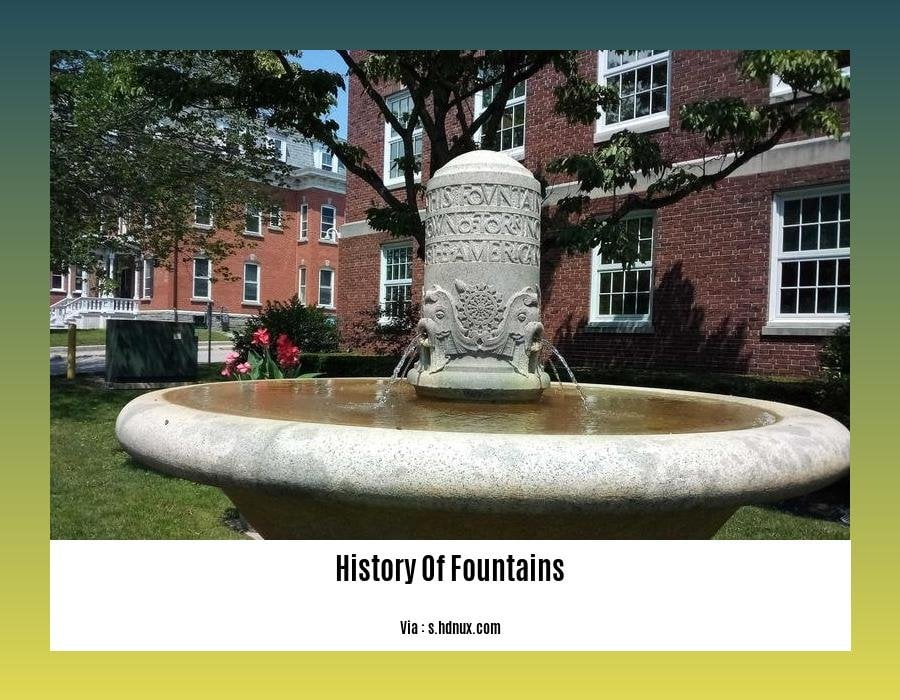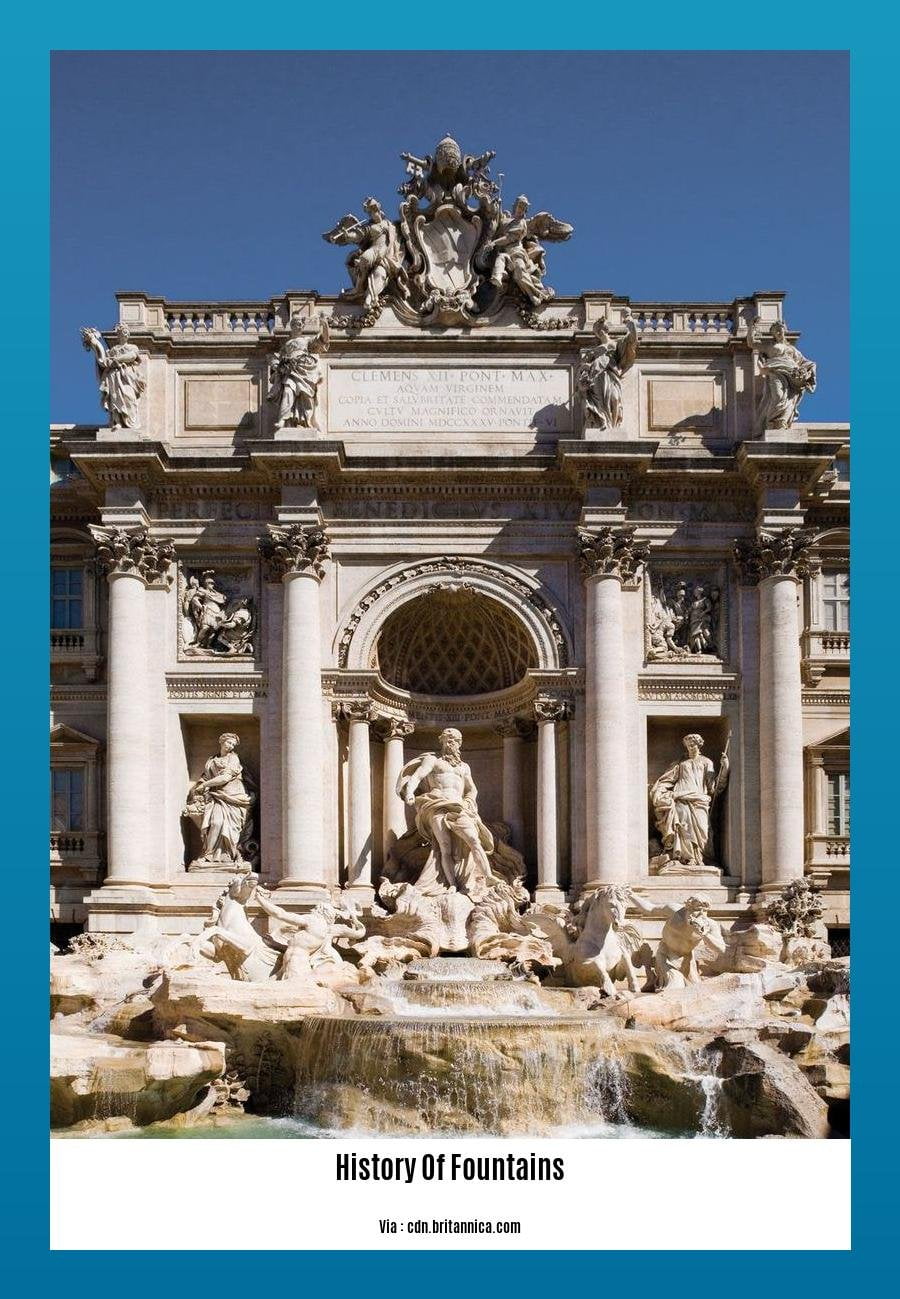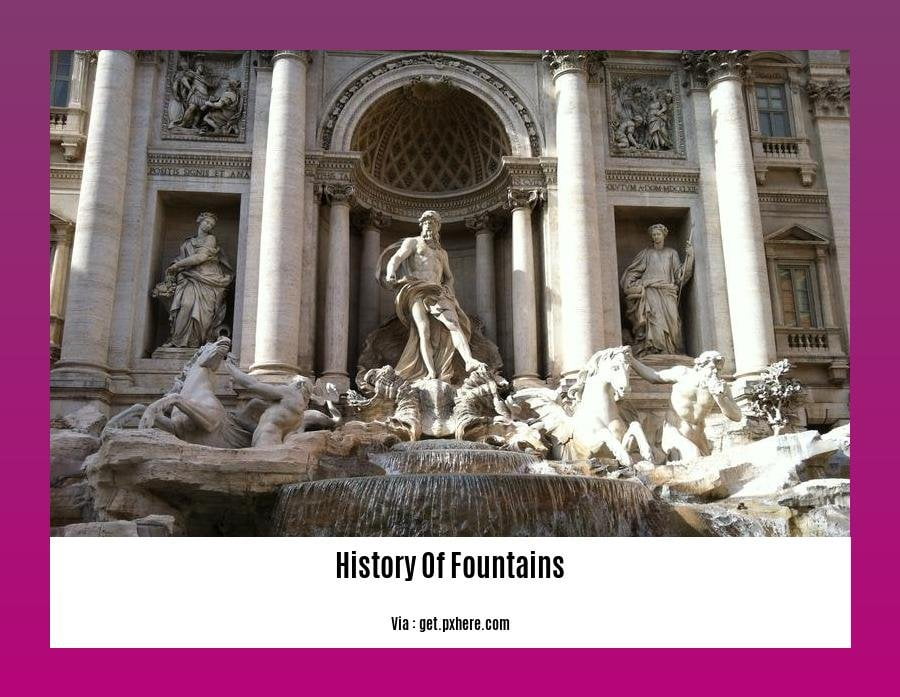Embark on a captivating journey through time as we unveil the rich history of fountains, a testament to human ingenuity and artistic expression. From ancient Rome to modern metropolises, fountains have graced public spaces, captivating hearts with their enchanting displays of water and intricate designs. Join us as we explore the evolution of these iconic landmarks, uncovering their enduring legacy and the stories they whisper to those who listen.
Key Takeaways:
Fountains, decorative water reservoirs, have diverse forms, including splash and drinking fountains.
The earliest known fountain dates back to 2000 BC, a carved stone basin used for scarce drinking water and religious ceremonies.
Ancient fountains relied on gravity to manage water flow, often positioned along water sources like aqueducts, streams, and rivers.
In the 19th century, fountains became part of public water systems, serving practical purposes such as watering animals.
The world’s tallest fountain, King Fahd’s Fountain, stands at an impressive 260 meters (853 feet) above the Red Sea in Jeddah, Saudi Arabia.
Musical fountains create a captivating spectacle, synchronizing music, light, and water through programmable spouts and jets.
History of Fountains

In the pursuit of beauty and functionality, fountains have graced our cities and public spaces for millennia. From humble origins to awe-inspiring spectacles, let’s delve into the fascinating history of fountains and explore their enduring legacy.
Ancient Origins: From Ritual to Refreshment
The earliest fountains were born out of necessity, serving as communal water sources in ancient civilizations. Found in Mesopotamia around 2000 BC, these simple stone basins held sacred water for drinking and religious ceremonies. As cities grew and water systems developed, fountains evolved into more elaborate structures, adorning palaces and religious sites. The Greeks and Romans, renowned for their architectural prowess, created monumental fountains that showcased their engineering skills and artistic sensibilities.
Medieval Marvels: Public Adornments and Engineering Feats
During the Middle Ages, fountains became increasingly prevalent in European cities, transitioning from purely functional to decorative elements. They often served as central gathering places, providing both drinking water and a social hub. Islamic civilizations, with their mastery of water engineering, constructed ingenious fountains that not only supplied water but also demonstrated their scientific prowess.
Renaissance and Baroque Splendor: Art, Symbolism, and Water Spectacles
The Renaissance ushered in a new era of artistic and cultural expression, and fountains became canvases for elaborate sculptures and intricate designs. Water features in palaces and gardens transformed into mesmerizing spectacles, showcasing the power and opulence of ruling monarchs. The Baroque period further embellished fountains, incorporating allegorical figures, mythology, and symbolism to create grandiose displays of water artistry.
Modern Engineering Marvels: Height, Harmony, and Illumination
The Industrial Revolution brought about new materials and technologies that pushed the boundaries of fountain design and engineering. The invention of pumps allowed fountains to reach unprecedented heights, challenging the laws of physics and gravity.Synchronized musical fountains, illuminated by vibrant lights, transformed public spaces into enchanting theaters of water, music, and light.
Fountains Today: Sustainable, Interactive, and Artistic Expressions
In contemporary times, fountains have evolved into more than just decorative features. They are expressions of sustainability, using recycled water and energy-efficient technologies. Interactive fountains allow visitors to engage and play, creating unique and memorable experiences. Artists and designers continue to push the boundaries of fountain art, creating thought-provoking and awe-inspiring sculptures that blur the lines between art and engineering.
So, the next time you pause to admire a fountain, take a moment to appreciate its rich history and enduring legacy. From humble beginnings to modern marvels, fountains have stood the test of time, showcasing the human quest for beauty, innovation, and a deep connection to water.
Interested in knowing the evolution of first aid practices throughout history? Delve into the history of first aid and discover the remarkable journey of medical assistance.
history of first aidEver wondered how the rules of football came to be? Unravel the history of football rules and explore the fascinating origins of the beautiful game.
history of football rulesCurious about the captivating history of Hindustani Classical Music? Explore the rich tapestry of its evolution and the influential figures who shaped its sound.
history of hindustani classical music
Symbolism and Cultural Significance: Fountains often held symbolic meanings, representing power, wealth, prestige, or religious beliefs, and became focal points for public gatherings and civic celebrations.

The world’s breathtaking fountains are more than just aesthetic marvels; they are embedded with profound symbolism and cultural significance. Since ancient times, these water features have symbolized power, wealth, prestige, and spiritual beliefs.
Beauty, Power, and Wealth
In ancient civilizations, fountains served as a symbol of power and authority. They showcased the wealth and grandeur of rulers and were often erected in prominent locations to impress visitors. The Greeks and Romans, known for their monumental fountains, used them to display their engineering prowess and artistic mastery.
Purity and Cleansing
Water has long been associated with purity and cleansing, and fountains embody this idea. In many cultures, fountains were used for religious ceremonies and rituals, as the flowing water was believed to purify and bless those who came in contact with it. This belief persists today, as fountains are often incorporated into sacred spaces and are frequently used for baptisms and other religious ceremonies.
Spiritual and Religious Symbolism
Fountains have held deep spiritual and religious significance in various cultures. In Hinduism, fountains symbolize the dual nature of the universe, representing both the male and female principles. In Christianity, fountains are associated with spiritual unity and the “Fountain of Life” mentioned in the Bible. The Islamic tradition also holds fountains in high regard, viewing them as symbols of paradise and the abundance of God’s blessings.
Iconic Fountains
Throughout history, fountains have become iconic landmarks, representing the cultural heritage and identity of cities. Some of the world’s most famous fountains include:
- Trevi Fountain in Rome, Italy
- Buckingham Palace Fountain in London, UK
- Magic Fountain of Montjuic in Barcelona, Spain
These fountains have become symbols of their respective cities and are visited by millions of tourists each year.
Key Takeaways:
- Fountains have held symbolic meanings throughout history, representing power, wealth, prestige, and religious beliefs.
- In ancient civilizations, fountains were seen as symbols of power and wealth, used to showcase the grandeur of rulers.
- Fountains have been associated with purity and cleansing, used in religious ceremonies and rituals.
- In various cultures, fountains hold deep spiritual and religious significance, symbolizing unity, paradise, and the abundance of divine blessings.
- Iconic fountains worldwide have become landmarks, representing cultural heritage and identity, attracting millions of tourists each year.
The Hidden Symbolism Of Water: 9 Symbolic Meanings – Subconscious Servant
20 KEY Water Fountain Feng Shui Rules You Should Know! – Feng Shui Pundit
Urban Beautification and Public Spaces: Fountains played a crucial role in shaping and beautifying cities, enhancing public spaces, and providing opportunities for leisure, relaxation, and social interaction.
Fountains, with their mesmerizing water displays, have played a profound role in urban beautification and the creation of vibrant public spaces. These majestic water features have adorned cityscapes for centuries, serving not only as aesthetic landmarks but also as functional and social hubs.
Fountains as Cornerstones of Urban Beautification
Visual Appeal: Fountains introduce a captivating element to the urban landscape. Their graceful arcs of water, shimmering reflections, and intricate designs create visual focal points that enhance the overall aesthetics of a city.
Soundscape: The gentle splashing and trickling of water from fountains add a soothing ambiance to urban spaces, creating a tranquil oasis amidst the hustle and bustle of city life.
Microclimate Regulation: Fountains contribute to microclimate regulation by releasing water vapor into the air, which helps reduce urban heat island effects and improves air quality.
Fountains as Enriching Public Spaces
Social Hubs: Fountains serve as gathering places for people from all walks of life. They provide a space for relaxation, socializing, and people-watching, fostering a sense of community.
Leisure and Recreation: Fountains offer opportunities for leisure activities such as sitting by the water, enjoying a picnic, or simply admiring the water displays.
Cultural Events: Many cities host cultural events and performances around their fountains, creating a vibrant atmosphere that attracts locals and tourists alike.
Fountains: A Catalyst for Economic Development
Tourism: Iconic fountains can become major tourist attractions, drawing visitors from around the world. This influx of tourism stimulates local economies and supports businesses in the surrounding area.
Real Estate Value: Properties located near well-maintained and attractive fountains tend to command higher real estate values, contributing to the overall economic development of the area.
Key Takeaways:
Fountains have evolved from purely ornamental features to multifaceted elements that enhance urban environments.
They contribute to urban beautification through visual appeal, soundscapes, and microclimate regulation.
Fountains serve as social hubs, providing spaces for relaxation, socializing, and community building.
They offer opportunities for leisure activities and cultural events, enriching the urban experience.
Iconic fountains can act as tourist magnets, boosting local economies and real estate values.
Proper maintenance and management are crucial to ensure the functionality, safety, and aesthetics of fountains.
Fountain design involves collaboration between architects, engineers, city planners, and local communities.
Sustainability considerations, such as water recycling and energy efficiency, are becoming increasingly important in fountain design.
Relevant URL Sources:
The Role of Fountains in Urban Beautification and Public Space
How Fountains Enhance Urban Environments
Legacy and Enduring Appeal: Many historic fountains have become iconic landmarks, attracting tourists and locals alike, symbolizing the cultural heritage and identity of the cities they adorn.
Take a moment and think about the most enchanting urban spectacle you’ve ever witnessed. Chances are, a majestic fountain may have captured your gaze. For centuries, fountains have been a beloved canvas for artistry, a testament to humanity’s enduring love affair with water and its boundless potential for delight.
Key Takeaways:
Heritage and History: Fountains often showcase intricate designs, sculptures, and symbols that reflect the culture and heritage of the city they’re located in. They are physical manifestations of a city’s past and present, offering a glimpse into its history and traditions.
Architectural Masterpieces: Many fountains are architectural marvels, showcasing the skill and artistry of their designers and builders. They are often focal points of public spaces, commanding attention with their grandeur and beauty.
Symbolism and Meaning: Fountains often carry symbolic meanings, representing everything from power and wealth to purity and renewal. They serve as powerful symbols of community identity and unity.
Public Gathering Places: Historic fountains have long been popular gathering places for people to socialize, relax, and enjoy themselves. They create a sense of community and provide a refreshing oasis in the midst of the urban hustle and bustle.
Enduring Appeal: The enduring appeal of historic fountains lies in their ability to transcend time and continue to captivate generations. They are cherished landmarks that evoke nostalgia, beauty, and a sense of awe.
Iconic Examples:
Trevi Fountain, Rome, Italy: This legendary fountain is known for its Baroque splendor and the tradition of throwing coins into its waters for good luck.
Magic Fountain of Montjuic, Barcelona, Spain: This awe-inspiring fountain offers a dazzling display of water, light, and music, attracting visitors worldwide.
Conclusion:
Historic fountains are more than just feats of engineering or architectural marvels; they are living embodiments of a city’s cultural heritage and enduring appeal. They captivate our imaginations, transport us to different eras, and serve as reminders of the enduring power of water and human creativity.
10 Most Famous Fountains in the World
38 Of The World’s Most Amazing Fountains
FAQ
Q1: What is the earliest known fountain, and what was its purpose?
Q2: How did fountains evolve from ancient times to the present day?
Q3: What are some of the famous fountains in the world, and what makes them unique?
Q4: What are the different types of fountains, and what are their respective characteristics?
Q5: What are the challenges and opportunities associated with the preservation and maintenance of historic fountains?
- Star Ring Trends: Etsy vs Amazon - March 28, 2025
- Boost Pollinator Habitats: Baby Blue Eyes Sustainable Farming Guide - March 28, 2025
- Protect Big Black Bears: Effective Conservation Strategies - March 28, 2025

![[Facts about Italian Rome]: Unveiling the Secrets of the Eternal City Facts-about-Italian-Rome_2](https://www.lolaapp.com/wp-content/uploads/2023/12/Facts-about-Italian-Rome_2-150x150.jpg)














